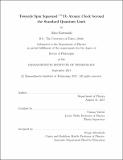Towards spin squeezed ¹⁷¹Yb atomic clock beyond the standard quantum limit
Author(s)
Kawasaki, Akio, Ph. D. Massachusetts Institute of Technology
DownloadFull printable version (15.84Mb)
Other Contributors
Massachusetts Institute of Technology. Department of Physics.
Advisor
Vladan Vuletić.
Terms of use
Metadata
Show full item recordAbstract
State-of-the-art atomic clocks have fractional frequency instability of 6 x 10-17 at 1 s averaging time, and are aiming for even higher stability. One of the main factors limiting this stability is the standard quantum limit (SQL) of quantum projection noise, which can be overcome by spin squeezing. We constructed an apparatus to perform spin squeezing on an ytterbium optical lattice clock to demonstrate the enhancement of clock stability by spin squeezing. Using the spin 1/2 system of the ground state Zeeman sublevels of 171Yb, two different methods are utilized to perform a spin squeezing via coupling to 6s6p3P1 excited state. One method is measurement-based squeezing, which gave 2.1 dB of spin squeezing. The latter method, cavity feedback squeezing, achieved 8.6 dB of inferred squeezing. The sequence is designed in such a way that the squeezing procedure is unitary, which is demonstrated by reverting the state to a coherent spin state after squeezing it, and the measurement does not require atom number measurement much more precise than the SQL. The squeezing of ground state is expected to be transferred to the 6s6p3P0 state, which is the excited state of the clock transition. This would be the first observation of an entangled state between a ground state and an electronic excited state, and the resulting spin squeezed atomic clock would be the first optical transition clock enhanced by spin squeezing.
Description
Thesis: Ph. D., Massachusetts Institute of Technology, Department of Physics, 2017. This electronic version was submitted by the student author. The certified thesis is available in the Institute Archives and Special Collections. Cataloged from student-submitted PDF version of thesis. Includes bibliographical references (pages 231-243).
Date issued
2017Department
Massachusetts Institute of Technology. Department of PhysicsPublisher
Massachusetts Institute of Technology
Keywords
Physics.